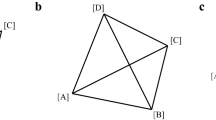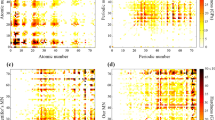Abstract
We show how a genetic algorithm (GA) generates efficiently the energy landscape of the equimolar calcite–magnesite (CaCO3—MgCO3) solid solution. Starting from a random configuration of cations and a supercell containing 480 atoms, the lowest energy form of ordered dolomite was found in all runs, in 94% of which it was located with less than 20,000 fitness evaluations. Practical implementation and operation of the GA are discussed in detail. The method can also generate both low-lying and high-lying excited states. Detailed analysis of the energy-minimised structures of the different configurations reveals that low energies are associated with reduction of strain associated with rotation of the carbonate groups, a mechanism possible only when a carbonate layer lies between a layer of just Ca and a layer of just Mg. Such strain relief is not possible in the equimolar MgO–CaO solid solution despite the similarity of the crystal structures of these binary oxides to calcite–magnesite, and therefore, the enthalpy of mixing is very high. Implications for thermodynamic configurational averaging over the minima in the energy landscape are briefly considered. Overall, the genetic algorithm is shown to be a powerful tool in probing non-ideality in solid solutions and revealing the ordering patterns that give rise to such behaviour.



Similar content being viewed by others
References
Allan NL, Barrera GD, Fracchia RM, Lavrentiev MY, Taylor MB, Todorov IT, Purton JA (2001) Free energy of solid solutions and phase diagrams via quasiharmonic lattice dynamics. Phys Rev B 63:094203
Althoff PL (1977) Structural refinements of dolomite and a magnesian calcite and implications for Dolomite formation in marine-environment. Am Mineral 62:772–783
Burton BP (1987) Theoretical analysis of cation ordering in binary rhombohedral carbonate systems. Am Mineral 72:329–336
Burton BP, Kikuchi R (1984) Thermodynamic analysis of the system CaCO3–MgCO3 in the tetrahedron approximation. Am Mineral 69:165–175
Burton BP, Van de Walle A (2003) First principles based calculations of the CaCO3–MgCO3 subsolidus phase diagrams. Phys Chem Miner 30:88–97
Bakken E, Allan NL, Barron THK, Mohn CE, Todorov IT, Stølen S (2003) Order-disorder in grossly non-stoichiometric SrFeO 2.50—a simulation study. Phys Chem Chem Phys 5:2237–2243
Catti M, Dovesi R, Pavese A, Saunders VR (1991) Elastic constants and electronic structure of fluorite (CaF2): an ab initio Hartree–Fock study. J Phys Condens Matter 3:4151–4164
Catti M, Pavese A, Dovesi R, Saunders VR (1993) Static lattice and electron properties of MgCO3 (magnesite) calculated by ab initio periodic Hartree–Fock methods. Phys Rev B 47:9189–9198
Chai L, Navrotsky A (1996) Synthesis, characterization, and energetics of solid solution along the CaMg(CO3)2–CaFe(CO3)2 join and implication for the stability of ordered CaFe(CO3)2. Am Mineral 81:1141–1147
Chai L, Navrotsky A, Dooley D (1995) Energetics of calcium–rich dolomite. Geochim Cosmochim Acta 59:939–944
Chan JA, Zunger A (2009) II–VI oxides phase separate whereas the corresponding carbonates order: the stabilizing role of anionic groups. Phys Rev B 80:165201
Chen FY, Curley BC, Rossi G, Johnston RL (2007) Structure, melting, and thermal stability of 55 atom Ag–Au nanoalloys. J Phys Chem C111:9157–9165
Chua AL-S, Benedek NA, Chen L, Finnis MW, Sutton AP (2010) A genetic algorithm for predicting the structures of interfaces in multicomponent systems. Nat Mater 9:418–422
Chuang FC, Ciobanu CV, Shenoy VB, Wang CZ, Ho KM (2004) Finding the reconstructions of semiconductor surfaces via a genetic algorithm. Surf Sci 573:L375–L381
Davidson PM (1994) Ternary iron, magnesium, calcium carbonates: a thermodynamic model for dolomite as an ordered derivative of calcite structure solutions. Am Mineral 79:332–339
Deaven DM, Ho KM (1995) Molecular-geometry optimization with a genetic algorithm. Phys Rev Lett 75:288–291
Deelman JC (1999) Low temperature nucleation of magnesite and dolomite. Neues Jahrbuch für Mineralogic Monatshefte 7:289–302
Dick BG, Overhauser AW (1958) Theory of the dielectric constants of alkali halide crystals. Phys Rev 112:90
Dovesi R, Orlando R, Civalleri B, Roetti C, Saunders VR, Zicovich-Wilson CM (2005) Z Kristallogr 220:571–573
Dovesi R, Saunders VR, Roetti C, Orlando R, Zicovich-Wilson CM, Pascale F, Civalleri B, Doll K, Harrison NM, Bush IJ, D’Arco P, Llunell M (2009) CRYSTAL09 user’s manual. University of Torino, Torino
Dudiy SV, Zunger A (2006) Searching for alloy configurations with target physical properties: impurity design via a genetic algorithm inverse band structure approach. Phys Rev Lett 97:046401
Ferrando R, Fortunelli A, Johnston RL (2008) Searching for the optimum structures of alloy nanoclusters. Phys Chem Chem Phys 10:640–649
Fisler DK, Gale JD, Cygan RT (2000) Am Mineral 85:217–224
Freeman CL, Allan NL, van Westrenen W (2006) Local cation environments in the pyrope-grossular Mg3Al2Si3O12–Ca3Al2Si3O12 garnet solid solution. Phys Rev B 74:134203
Gale JD (1997) The general utility lattice program GULP—a computer program for the symmetry adapted simulation of solids. J Chem Soc Faraday Trans 93:629–637
Gale JD (2005) GULP: capabilities and prospects. Z Krist 220:552–554
Gale JD, Rohl AL (1997) Mol Simul 29:291–234
Goldberg DE (1989) Genetic algorithms in search, optimization and machine learning. Addison Wesley, Reading
Holland JH (1975) Adaption in natural and artificial systems. University of Michigan Press, Ann Arbor
Johnston RL (2003) Evolving better nanoparticles: genetic algorithms for optimising cluster geometries. Dalton Trans 22:4193–4207
Lavrentiev M, Yu, van Westrenen W, Allan NL, Freeman CL, Purton JA (2006) Simulation of thermodynamic mixing properties of garnet solid solutions at high temperatures and pressures. Chem Geol 225:336–346
Lyakhov AO, Oganov AR, Valle M (2010) How to predict very large and complex crystal structures. Comput Phys Commun 181:1623–1632
Lyakhov AO, Oganov AR, Stokes HT, Zhu Q (2013) New developments in evolutionary structure prediction algorithm USPEX. Comput Phys Commun 184:1172–1182
McCarthy MI, Harrison NM (1994) Ab initio determination of the bulk properties of MgO. Phys Rev B 49:8574–8582
Mohn CE, Kob W (2009) A genetic algorithm for the atomistic design and global optimisation of substitutionally disordered materials. Comput Mater Sci 45:111–117
Mohn CE, Kob W (2015) Predicting complex mineral structures using genetic algorithms. J Phys Condens Matter 47:425201
Mohn CE, Stølen S (2005) Genetic mapping of the distribution of minima on the potential energy surface of disordered systems. J Chem Phys 123:114104
Mohn CE, Lavrentiev MY, Allan NL, Bakken E, Stølen S (2005) Size mismatch effects in oxide solid solutions using Monte Carlo and configurational averaging. Phys Chem Chem Phys 7:1127–1135
Mohn CE, Stølen S, Kob W (2011) Predicting the structure of alloys using genetic algorithms. Mater Manuf Process 26:348–353
Navrotsky A (1987) Models of crystalline solutions. In: Reeder RJ (ed) Reviews in mineralogy, vol 17. Mineralogical Society of America, Washington, DC
Navrotsky A, Capobianco C (1987) Enthalpies of formation of dolomite and of magnesian calcites. Am Mineral 72:782–787
Navrotsky A, Dooley D, Reeder R, Brady P (1999) Calorimetric studies of the energetics of order–disorder in the system MgxFe1−xCa(CO3)2. Am Mineral 84:1622–1626
Oganov AR, Stokes HT, Zhu Q (2006) Crystal structure prediction using ab initio evolutionary techniques: principles and applications. J Chem Phys 124:244704
Oganov AR, Chen J, Gatti C, Ma Y-Z, Ma Y-M, Glass CW, Liu Z, Yu T, Kurakevych OO, Solozhenko VL (2009) Ionic highpressure form of elemental boron. Nature 457:863–867
Oganov AR, Ma Y, Lyakhov AO, Valle M, Gatti C (2010) Evolutionary crystal structure prediction as a method for the discovery of minerals and materials. Rev Miner Geochem 71:271–298
Oganov AR, Lyakhov AO, Valle M (2011) How evolutionary crystal structure prediction works—and why. Acc Chem Res 44:227–233
Purton JA, Blundy JD, Taylor MB, Barrera GD, Allan NL (1998a) Hybrid Monte Carlo and lattice dynamics simulations: the enthalpy of mixing of binary oxides. Chem Commun. https://doi.org/10.1039/A708907D
Purton JA, Parker SC, Allan NL (1998b) Monte Carlo and hybrid Monte Carlo/molecular dynamics approaches to order–disorder in alloys, oxides and silicates. J Phys Chem B 102:5202–5207
Purton JA, Allan NL, Lavrentiev MYu, Todorov IT, Freeman CL (2006) Computer simulation of mineral solid solutions. Chem Geol 225:176–188
Purton JA, Lavrentiev MY, Allan NL (2007) Monte Carlo simulation of GaN/AlN and AlN/InN mixtures. Mater Chem Phys 105:179–184
Purton JA, Parker SC, Allan NL (2013) Monte Carlo simulation and free energies of mixed oxide nanoparticles. Phys Chem Chem Phys 15:6219–6225
Putnis A (1992) Introduction to mineral science. Cambridge University Press, Cambridge
Shannon RD (1976) Revised effective ionic radii and systematic studies of interatomic distances in halides and chalcogenides. Acta Crystallogr A32, 751–767
Sluiter MHF, Vinograd V, Kawazoe Y (2004) Intermixing tendencies in garnets: pyrope and grossular. Phys Rev B 70:184120
Smith RW (1992) Energy minimization of binary alloy models via genetic algorithms. Comput Phys Commun 71:134–146
Taylor MB, Barrera GD, Allan NL, Barron THK, Mackrodt WC (1997a) The free energy of formation of defects in polar solids. Faraday Discuss 106:377–387
Taylor MB, Barrera GD, Allan NL, Barron THK (1997b) Free energy derivatives and structure optimisation within quasiharmonic lattice dynamics. Phys Rev B56:14380–14390
Taylor MB, Barrera GD, Allan NL, Barron THK, Mackrodt WC (1998) SHELL—a code for lattice dynamics and structure optimisation of ionic crystals. Comput Phys Commun 109:135–143
Todorov IT, Allan NL, Lavrentiev MYu, Freeman CL, Mohn CE, Purton JA (2004) Computer simulation of mineral solid solutions. J Phys Condens Matter 16:S2751–S2770
Towler MD, Allan NL, Harrison NM, Saunders VR, Mackrodt WC, Aprà E (1994) Ab initio Hartree–Fock study of MnO and NiO. Phys Rev B 50:5041–5054
van Westrenen W, Allan NL, Blundy JD, Lavrentiev MYu, Lucas BR, Purton JA (2003) Trace element incorporation into pyrope-grossular solid solutions: an atomistic simulation study. Phys Chem Minerals 30, 217–229
Vinograd VL, Burton BP, Gale JD, Allan NL, Winkler B (2007) Activity–composition relations in the system CaCO3–MgCO3 predicted from static structure energy calculations and Monte Carlo simulations. Geochim Cosmochim Acta 71:974–983
Vinograd VL, Sluiter M, Winkler B (2009) Subsolidus phase relations in the CaCO3–MgCO3 system predicted from the excess enthalpies of supercell structures with single and double defects. Phys Rev B 79:104201
Woodley SM (2009) Structure prediction of ternary oxide subnanoparticles. Mater Manuf Process 24:255–264
Woodley SM, Catlow CRA (2008) Crystal structure prediction from first principles. Nat Mater 7:937–946
Woodley SM, Battle PD, Gale JD, Catlow CRA (1999) The prediction of inorganic crystal structures using a genetic algorithm and energy minimisation. Phys Chem Chem Phys 1:2535–2542
Zhang J, Reeder RJ (1999) Comparative compressibilities of calcite-structure carbonates; deviations from empirical relations. Am Mineral 84(5–6):861–870
Zhang J, Wang CZ, Ho KM (2009) Finding the low-energy structures of Si[001] symmetric tilted grain boundaries with a genetic algorithm. Phys Rev B 80:174102
Zhu Q, Oganov AR, Glass CW, Stokes HT (2012) Structure prediction for molecular crystals using evolutionary algorithms: methodology and applications. Acta Cryst B 68:215–226
Acknowledgements
NLA is grateful for valuable discussions with Victor Vinograd which prompted this work. This work was, in part, performed on the Abel Cluster, owned by the University of Oslo and the Norwegian metacenter for High Performance Computing (NOTUR), and operated by the Department for Research Computing at the University of Oslo IT-department. CM acknowledges support from the Research Council of Norway through its Centres of Excellence funding scheme, project number 223272.
Author information
Authors and Affiliations
Corresponding author
Rights and permissions
About this article
Cite this article
Allan, N.L., Thomas, L., Hart, J.N. et al. Calcite–magnesite solid solutions: using genetic algorithms to understand non-ideality. Phys Chem Minerals 46, 193–202 (2019). https://doi.org/10.1007/s00269-018-0997-3
Received:
Accepted:
Published:
Issue Date:
DOI: https://doi.org/10.1007/s00269-018-0997-3




